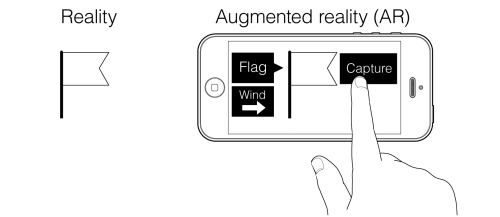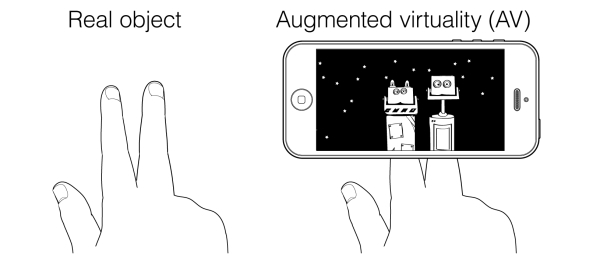Today, video games are an integral part of human leisure. People spend hours in virtual worlds and in most cases, this is a very pleasant experience that makes them glad and sometimes even happy. But what if the games and their principles began to pervade into wider areas of human reality? What do you think about games being an integral part of reality?
The meaning of augmented reality (AR) can be derived from the name itself: a reality that is augmented (enriched) by some sort of digital media. The process takes place in real time. It is interactive. The computer-generated elements are tightly connected with fragments of objective physical reality and have some specific reactions to them.
The following figure provides a schematic presentation of AR:

For example, when a system recognizes some landmarks in the game scene, it shows a textual description, plays a video, or displays some sort of 3D content. This information is strongly connected to a specific object, marker, or location.
To interact with AR, special devices are needed such as a computer system with a mounted camera, and some additional sensors may be required. The most advanced example is a heavy, head-mounted display. Most of them are pretty expensive and not easy enough to use everyday, especially outdoors. Fortunately, there is another example, that is, modern mobile devices that feature quite fast chips, good quality cameras, and some special installed software meaning they can easily overlay a representation of reality with some additional information. Moreover, they have given an extra boost to the popularity of AR technology because it is very handy to look at and use AR content on a smartphone rather than a personal computer. Because it is mobile, users have greater freedom to move and tilt the smartphone device to examine objects.
Now, AR is in fashion because so many branches of the modern economy see potential advantages in utilizing this technology. It is used in domains such as engineering, science, medicine, construction, education, commerce, advertising, and of course, entertainment (including games). The number of applications is growing everyday.
The following figure provides a schematic presentation of uugmented virtuality:

In augmented reality, where the real environment plays a major role, some virtual elements are only useful additions, such as A ugmented Virtuality (AV), which can be considered as AR's antipodes. In AV, the virtual space plays the major part, but the real objects are only a minor or functional element. Let's imagine an interactive-surface computer system (something similar to Microsoft PixelSense) that is capable of recognizing real objects placed on it. All computer-generated images displayed on the screen are part of the virtual environment, but a playing dice put on the surface is a real object. If the system would recognize the dice and read the value it would have on its top, since we would see the AV in action. So, the system uses fragments of reality to change virtuality. The usual example of AV is a weather forecast on TV where the background is CGI, but the host is a real human. AR and AV both are part of a space called Mixed reality (MR), which is an environment where real and virtual elements are blended in various proportions.
